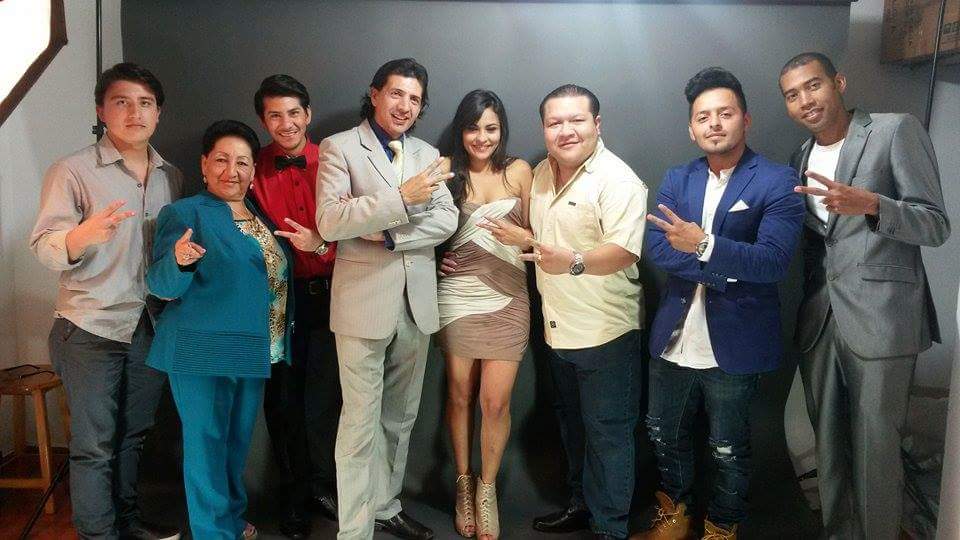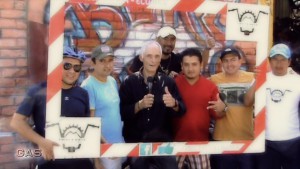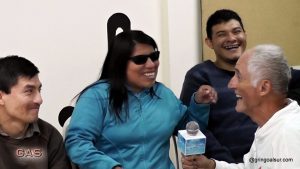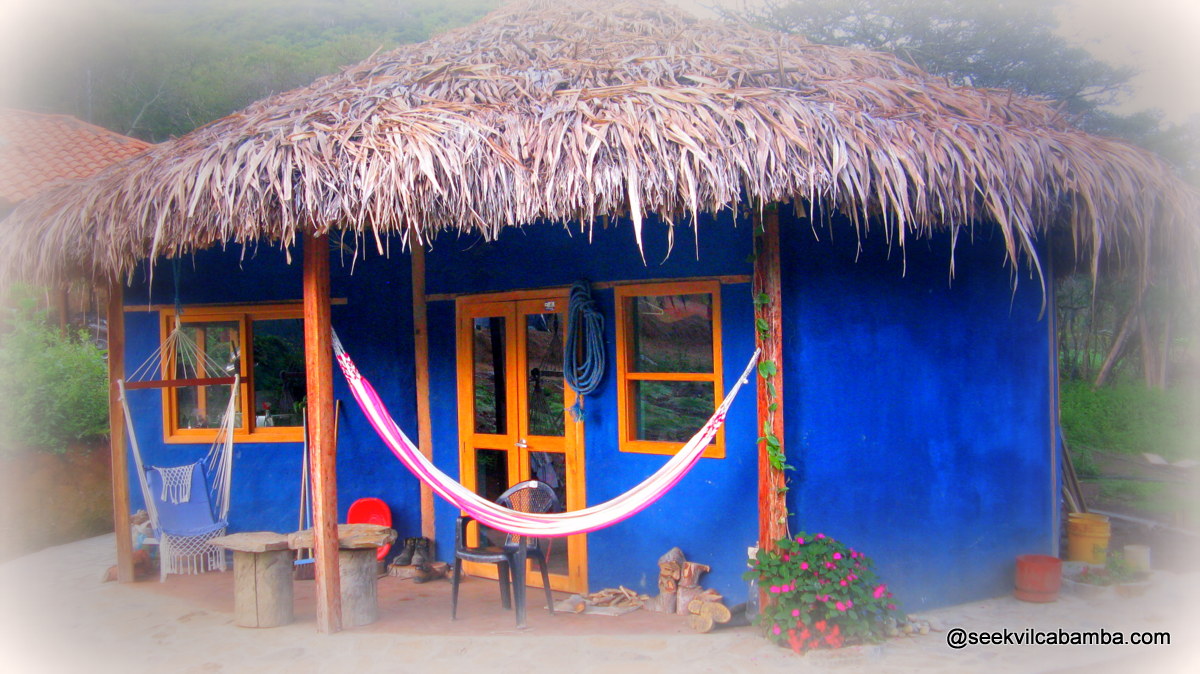July 2010 Journal
By Anita Evans
Vilcabamba Loja – Ecuador
Source: bbxmusic.com
The inspiration of Rain
Porches in Ecuador are a norm they are large with a roof that overhangs them completely. I suspect this is for several reasons.
One, construction, traditionally houses here are made from rammed earth or adobe blocks both of which require wide eves to protect them from rain and the weather.
Two, as a lot of peoples living occurs outdoors due to the climate a large covered porch acts as an outdoor living space as well as a work area for drying the coffee beans, maize and washing.
The house we are living in has a porch all the way around it and it is covered completely by a roof – known to some as a veranda instead of porch.
Our neighbours chickens and roosters use our porch as a freeway to get to the other side of our garden. As with cars on freeways, the chickens tend to leave a trail of pollution behind them in this case, chicken shit. Fortunately for them, the rooster is stunning and we love watching him so they get to use the porch. Unfortunately for us, someone has to clean up the pollution left behind.
So I’ve been looking at our porch that goes completely around the house (and the drops of chicken shit go completely round the house too) thinking it could really do with a clean but not been inspired to do it.
Now for those of you that might be screwing up your nose up at this – chicken shit, thinking I would not allow chickens to run around my house! They’d be in a chicken coup etc etc. Get over it – get real! Someone still has to clean up the chicken coup too you know!
Today it poured (rained) and I mean poured down. We had thunder and lightning to boot. It rained so hard and horizontal that the rain came in under the porch right up to the walls and windows of the house (very unusual). The veranda was soaking wet.
A good thing about it raining here in Vilca is it is warm. If you come from a colder countryplace similar to where I do when it rains and blows a storm you generally want to just burry yourself indoors and not venture out as it is freezing, cold, grey and gloomy.
Here today the rain inspired me – to clean the veranda. Since it was already soaking wet and it was warm and still bright outside. So when the rain eased off and wasn’t coming in horizontal anymore the eves gave me shelter from it. The rain also helped loosen up the chicken shit so it came off easier.
So, the rain here is inspiring not something to cringe from and what till it passes. And we have a clean veranda again!
What makes the esSence of a Society?
Here (well at least in Vilca I cannot say for the larger cities of EC) when you buy a beer in a bottle if you return the bottle (clean) you get 25c back. The same goes for the Pony bottles (10c back). They recycle the bottles here.
What this means is that you return them to the place you got them from so over time you and the store keeper get to know each other and the experience of just buying or returning your beer bottles develops a deeper meaning. You develop a rapport. This is one of the things that are missing from big cites and more obvious in the western world in general.
I remember when I grew up in good old NZ (not what it is now) one of the jobs for us kids was to take the milk bottles out and put them at the top of the drive way around 5 pm. The milk man would come and collect the old bottles and give more bottles filled with milk. The money for the milk would be in coins in one of the empty bottles. The number of empties out (+ money) = the number of full milk bottles you got back. No one stole the money, no one broke the bottles.
The same was for dad’s beer bottles the empties would be cleaned and returned to the place of purchase and 10c paid for each bottle returned. Us kids would clean them, collect them and return them to the store and spend the money on lollies. J 10c bought a lot in those days.
The bottles would be sterilised and reused by the beermilk companies.
I distinctly remember when this all changed in New Zealand. Some politically correct dickhead decided it was not ‘hygienic’ to do this. Then the companies decided that the cost of collection and cleaning was too expensive and it was more ‘cost effective’ to keep producing new bottles. The collection of the empties ended. Now, New Zealand, like the rest of the ‘modern world’, has a huge glass bottle waste problem.
So there were no more trips to the local store for us kids. The store keeper lost that rapport with his clients.
The milk man fizzled out too. People started stealing the money from the bottles, breaking the bottles so then the milk man had to issue invoices so his ‘paperwork’ time went through the roof which ate into his profits and poof he was gone.
Go to the supermarket to buy your milk and you’ll be lucky if the check operator makes eye contact with you. We now have a problem of what to do with all the plastic milk bottles or the cardboard ones that add to our land fife piles.
So what makes the essence of a society? One aspect is that connection you build up with the local people whom you get services from through regular contact over time. Your shopping becomes a social outing. The reputation of the business is based on the business owner and their service and reliability not on the cheapest, best deal you can get. You know you can rely on that person’s knowledge. You have trust between you. They know they can rely on your business. You pass them in the street and say ‘hi’ and ask how their family is. More then likely your kids play together.
This is what it is still like in the villages of Ecuador. There is a fibre of energy that makes the villages a nice place to live. Please don’t change.
an Article to Share with you
The following is some bulleted points from a brilliant article written by Martha Beck.. The full article is available on http://www.oprah.com/spirit/Martha-Becks-Problem-Solving-Strategies-Decision-Making-Advice . Martha Beck is a life coach, columnist and author. Her website is: http://www.marthabeck.com/
How to solve a thorny problem
- We are used to living in an either – or world – but when it comes to yes – or – no dilemmas, the most powerful thing you can ask is:
“What if both answers are true?”
- There are two kinds of people in the world; those who divide everyone into two kinds of people, and those who don’t. (my emphasis)
- But limiting ourselves to one answer means we often stop seeing what’s actually happening, and we make decisions based on labels instead: “The guy is a player……..so no date”, or “This friendship is dysfunctional……begone!”This strategy feels right…..until the guy or the friend does something truly sweet, gives you the kindness and affection you love and need, and there you are, spiked again on the opposing horns of the duel-emma.
- … we make judgements about all kinds of people, …We’re not only shocked when those assumptions don’t hold up; we’re unsure how to handle the new information.
- The only option….., for anyone who’s confronted with two apparently opposite sets of data, is to blast apart the mental dichotomies that organize our minds and drive our behaviour.
- If you scrutinize your own life, you’ll find you do plenty of things that violate the dichotomies in your mind.We’re considerate, selfless, and clever (except for the times we aren’t) or we’re luckless losers (not counting the infinite things that go right for us every day).
- … the problem with either-or thinking. It keeps us removed from reality, and it requires that we spend a lot of time and energy convincing ourselves that life is one particular way (and burying evidence that doesn’t jibe with that view)
- What makes a both-and mind-set so powerful is that it takes you beyond the two choices you thought you had. It opens up new, previously unseen possibilities and opportunities.
- There is one caveat to all duel-emma relationships; if you or the other person involved can’t or won’t admit the whole truth – “Yup, I have a Dr Jekyll side, but there’s also a Mr. Hyde in here” – the relationship will become increasingly dysfunctional. If both parties can discuss the full range of their behaviour, however, almost any relationship can work.Try seeing your world and yourself this way, eyes open to whatever is before you, mind free of dichotomies. Are you good or bad, fragile or tough, wise or foolish?
- YES. And so am I.
wheel clamping
I have already mentioned this under the Loja section of bbxmusic.com . However, we have discovered more about this practice this month. See we got clamped again. Yes, our parking ticket was displayed and filled out correctly. However, what we did not know is, it had expired. Seems the card is only valid for 90 days.
So the cards for parking expire and they appear to have a zone on them too. Ours said Zone A. So I guess Loja is broken up into zones. And a zone A card is only valid for zone A. So far we must have been in the correct zone for our card as we haven’t been clamped for being in the wrong zone, yet. Or maybe they have future proofed the cards and zones are going to be introduced in the future.
So what do you do if you get clamped?
You will have a parking ticket under your windscreen wiper. Take this ticket to the Municipality offices at Parque Central Loja. This is the large green building on the same side of the Parque Central as the Turistico Information Centre. You will have to the pay a fine (in our case it was $3). The Municipal staff then radio to the parking warden that car ‘blaa’s’ ticket has been paid and could they please go and unclamp it. Now, go DIRECTYLY back to your car. Do not pass GO or stop and window shop. If you need a new parking card get it once you are at your car. See your window of opportunity here is not long. Your car will be unclamped. The traffic warden will do hisher round again (they do this very fast) if they come pass your car and it doesn’t have a valid time + card on it you will be clamped again.
Food Poisoning
I suspect Emily and I have been hit by a bout of food poisoning from a restaurant we ate at. Emily had vomiting, fever and diarrhoea for one day followed by several more days of diarrhoea. Me I had fever and cramps that lasted 24 hours. I treated Emily as I would have done back in New Zealand. I gave her a mixture of natural supplements to combat bacteria and virus infection and to support the immune system and bowel and monitored the fever. Monitored her water intake and added a mineral supplement to her water. I took her off meats and grease and onto a raw, natural diet.
She also saw Vicente Valdivieso who is a very qualified naturopath here in Vilca. She went through a Hulda Clarke zapping protocol (so did I) and also iodine supplement. Vicente also treated her and me for parasites so we covered all our bases.
At no point should you stop the diarrhoea (though I am sure there are those out there who disagree, but let’s not go there. This journal is my opinion and you are entitled to yours). Diarrhoea is the body’s way of getting rid of the bad stuff inside the body.
What you need to do is support the body during this process by ensuring fluid intake is good and mineral supplements are given to compensate for the loss. As well as everything else I mention above.
Parasites
Argh, this is a topic we don’t like talking about in western civilised countries. I guess we like to think we are beyond them now we are civilised. Wake up call, you are not, parasites don’t give a toss if you are in a civilised country or not. They exist everywhere. I remember when growing up in NZ my mum would do a parasite cleanse twice a year for the whole family (animals included). This consisted of taking this red tablet. There was never any pain or discomfort. Pierre remembers similar too his mum treating him for parasites.
Ecuador is perceived as having a higher contamination with parasites then say a ‘1st world country’. This is what the mainstream medical establishment wants you to believe. Thus, reinforcing the notion that 1st world countries are healthier and safer to live in than other countries, which could be true for things like yellow fever and malaria. But then again is it not that malaria and yellow fever are tropical diseases and that these tropics just happen to be mostly in none 1st world countries. Maybe it has nothing to do with the status of the country but more its location on the planet?
So, back to parasites. Here in EC as in ANY country you should do a parasite cleanse every 6 months. Now there are those out there that will argue that if a person’s terrain (as in the internal well being of their body) is in good condition they will not become susceptible to parasite infestation. Wake up call, kid yourself not, your terrain isn’t good, period. I doubt whether anyone has the level of ‘good terrain’ that would make them un- susceptible to parasites given the amount of overall pollutants that are now in the atmosphere, water, earth of the entire planet. Really unless you’ve done a whole heap of tests on yourself you have no dam idea what your terrain is like. Your ego might like to make out you are above average in this area but are you really? Just because you eat raw, meditate, have the ‘right thinking and attitude’ whatever does not make your terrain healthy, this is a false belief.
There is no harm in doing a parasite cleanse there are natural and pharmaceutical approaches to this. There is potentially (serious) harm in not doing one. Now again people will say that parasites are all around us they are a part of life. This again works fine if your terrain is in optimum and I emphasise optimum health. But how can you be sure for sure?
So keep up your parasite cleansing every 6 months no matter where you live. A good book on this is ‘The Cure for all Diseases’ by Hilda Clarke.
Do you really need that test?
When you are pregnant and 35 or older you are strongly advised by the doctormidwife to have an amino test to determine the health of the baby and if the baby had any birth defects.
I didn’t. Why didn’t I? Well, I got to thinking Ok I take this test and the results come back positive for birth defects what would I do with this information? I have two options:
Abort or not abort.
So the question came down to would I abort? The answer was no, there was no reason on this planet I would abort this baby.
Then my thoughts went to, if the result was positive for birth defects and I chose not to abort I then have to live with this knowledge for the rest of the pregnancy and this knowledge being of such a ‘sad’ nature would interfere with my ability to enjoy the pregnancy for what is was – being pregnant.
Then my thoughts considered the fact that it is well known that 50% of test results are wrong – false positives or false negatives. So I could go through all this worry and have a baby with no birth defects despite the test results.
Then I thought of our ancestors who didn’t have these test and accepted the child they were given.
So I chose to not do the test and enjoy the pregnancy for what is was. And accept my baby for who they would be.
I was talking with a friend the other day that said that other people were recommending that the water sources in their area be tested for contamination. There is talk of illegal mining where they live and that the miners poor mercury into the rivers which are used as the main source of drinking water for most person in their neighbourhood.
I answered this with “And what are you going to do with the test results?” “What is your plan should they come back showing contamination?”
The reply I got was “We haven’t really thought about that.”
My point here is: what is the point of doing any test if you don’t consider what you are going to do first, should the results come back bad?
If you are not prepared to abort why get an amino?
So they find out the water is contaminated. Which I say it is in some parts of the rivers given what goes into them from the people living here let alone any illegal mining practices. You only have to watch life in their neighbourhood to understand this you don’t need to do any tests.
What are they going to do with this information? Go to the government, hmmm that could take a long time. Find the source of the contamination? Put in water purifiers in their homes (which is the best option and one that should probably be done regardless of tests or no tests)?
In Nelson New Zealand the local council did water tests on all the rivers and streams in Nelson grading them from A being perfect to D being the worst. The tests were run over several months at different times during each month etc. Most rivers failed many coming in at C or below which is not fit for human consumption. Yet people still drunk the water for it was the only water source they had.
You must consider your options prior to getting tests done. What are you going to do with the information? What is your plan? What are your beliefs and will they stop you from certain courses of action? What are the resources available to you and could a lack of them stop you from a course of action?
After a good analysis what are your realistic options available to you upon receipt of the results should they be bad?
Remember, sometimes knowing can be more damaging to your health through worry (especially if you can’t do anything about the problem and are stuck) then not knowing. It is known that you can worry yourself sick.









